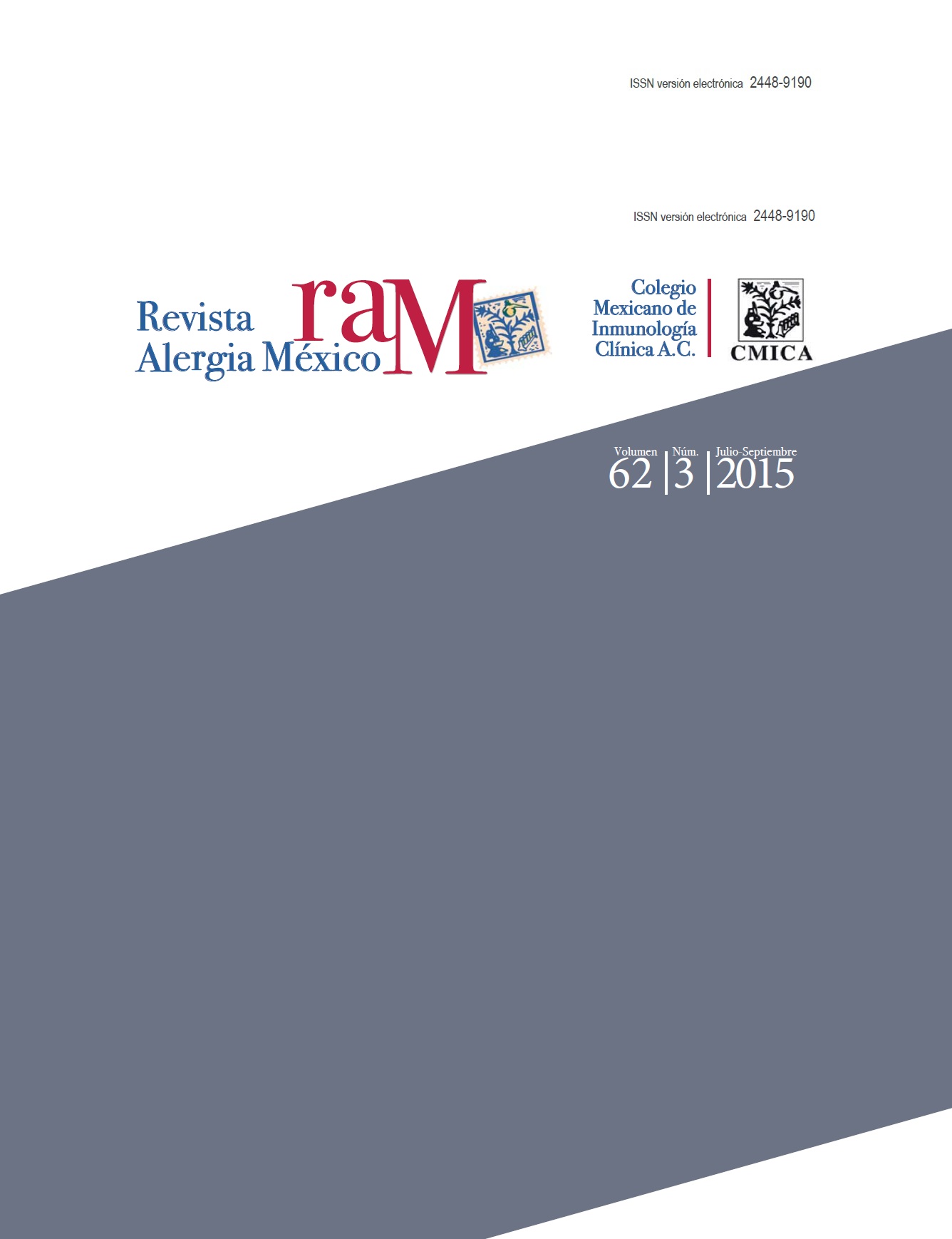Abstract
Background: Salicylates intolerance is related to alteration in the metabolism of arachidonic acid leading to increased leukotrienes. The condition may be manifested with respiratory, skin or systemic symptoms or associated with sinonasal polyposis. Salicylates are present in anti-inflammatory drugs, cosmetics products and food.
Objective: To determine the prevalence of salicylates intolerance in patients with sinonasal polyposis presenting to Clinical Immunology and Allergy and Otolaryngology Service, CMN 20 Noviembre, Mexico City.
Material and method: An observational, descriptive, cross sectional study included patients with sinonasal polyposis. The sample size was 49 patients, and variables were compared using STATISTICA 8.0.
Results: The prevalence of sinonasal polyposis was 4% of the study group, predominantly in females; only 24% of the population had an ideal weight, the salicylates intolerance prevalence was 53%, and the Samter triad was 31%.
Conclusions: Sinonasal polyposis has an inflammatory disease pattern. Its pathophysiology is not yet fully established and in this study was related to obesity and persistent sinusitis. The most feared complication recurrence is associated with salicylates intolerance. The study found a slight increase of recurrence in the group of intolerance, with no statistically significant difference, possibly related to the sample size.
References
Wolf Baenkler H, Ärzteblatt D. Salicylate intolerance pathophysiology, clinical spectrum, diagnosis and treatment. Deutsches Ärzteblatt International 2008;105:137-142.
Gajardo P, Fonseca X. Aspirin intolerance in patients with nasal polyps and asthma. Revista de otorrinolaringología y cirugía de cabeza y cuello 2009;69:157-168.
Scotter M. Free salicylic acid and acetyl salicylic acid content of foods using gas chromatography–mass spectrometry. Food Chemistry 2007;105:273-279.
European Position Paper on Rhinosinusitis and Nasal Polyps (EPOS 2012).
Chaaban MR, et al. Epidemiology and differential diagnosis of nasal polyps. Am J Rhinol Allergy 2013;27:473-478.
Shabbir A, Mubasher I, Iqbal A, Tariq D. Factors associated with recurrent nasal polyps. A tertiary care experience. JPMA 2010;60. 7.
Casale M, Pappacena M, Potena M, Vesperini E. Nasal polyposis: from pathogenesis to treatment, an update. Inflammation & Allergy Drug Targets 2011:10:158-163.
Pamela A, Rohit K, Raeful A. Variations in expression of matrix metalloproteinase-9 and tissue inhibitor of metalloproteinase- 1 in nasal mucosa of aspirin-sensitive versus aspirin-tolerant patients with nasal polyposis. Ann Allergy Asthma Immunol 2011;107:353-359.
Wang L, Chien C, Tai C, Kuo W. Matrix rmetalloproteinase-9 gene polymorphisms in nasal polyposis. BMC Medical Genetics 2010;11:1471-2350.
DeMarcantonio M, Han J. Nasal polyps: pathogenesis and treatment implications. Otolaryngology Clin N Am 2011;44:685-695.
Roongrotwattanasiri K, Pawankar R, Kimura S. Decreased expression of FOXP3 in nasal polyposis. Allergy Asthma Immunol Res 2012;4:24-30.
Macoto Kosugi E. Interleukin-6 -174 G/C promoter polymorphism and nasal polyposis. Rhinology 2009;47:400-404.
Newton J, Wong K. A review of nasal polyposis. Therapeutics and Clinical Risk Management 2008:4:507-512.
Masterson L, Tanweer F, Bueser T. Extensive endoscopic sinus surgery: does this reduce the revision rate for nasal polyposis? Eur Arch Otorhinolaryngology 2010; 267:1557- 1561.
Guías Internacionales de ARIA 2008, GINA 2011, WAO 2011, EPOS 2012.

This work is licensed under a Creative Commons Attribution-NonCommercial 4.0 International License.
Copyright (c) 2015 Revista Alergia México

